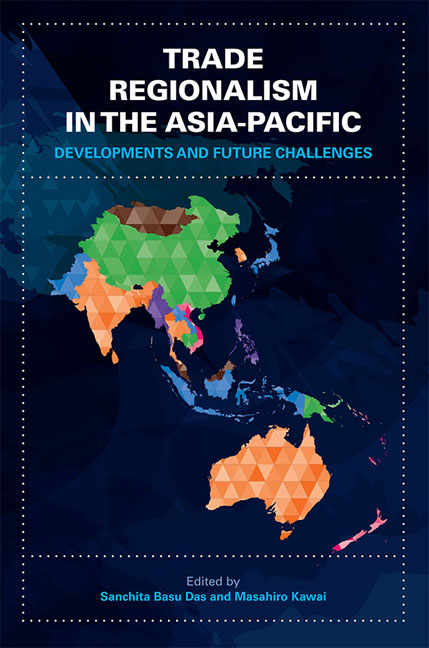Book contents
- Frontmatter
- Contents
- Foreword
- Acknowledgments
- List of Abbreviations
- The Contributors
- 1 Introductory Overview — Trade Regionalism in the Asia-Pacific: Developments and Future Challenges
- I The Trans-Pacific Partnership (TPP) Agreement
- II The Regional Comprehensive Economic Partnership (RCEP) Agreement
- III Regional Economic Integration: A Multi-stage Approach
- IV Old and Emerging Approaches to Asia-Pacific Regional Integration
- 12 APEC at 25: Political Realities Realized
- 13 The TTIP, Mega-regionalism and Asia
- 14 The Pacific Alliance: A Bridge between Latin America and the Asia-Pacific?
- V Asia-Pacific Regional Integration: Towards Convergence?
- Index
14 - The Pacific Alliance: A Bridge between Latin America and the Asia-Pacific?
from IV - Old and Emerging Approaches to Asia-Pacific Regional Integration
Published online by Cambridge University Press: 05 July 2016
- Frontmatter
- Contents
- Foreword
- Acknowledgments
- List of Abbreviations
- The Contributors
- 1 Introductory Overview — Trade Regionalism in the Asia-Pacific: Developments and Future Challenges
- I The Trans-Pacific Partnership (TPP) Agreement
- II The Regional Comprehensive Economic Partnership (RCEP) Agreement
- III Regional Economic Integration: A Multi-stage Approach
- IV Old and Emerging Approaches to Asia-Pacific Regional Integration
- 12 APEC at 25: Political Realities Realized
- 13 The TTIP, Mega-regionalism and Asia
- 14 The Pacific Alliance: A Bridge between Latin America and the Asia-Pacific?
- V Asia-Pacific Regional Integration: Towards Convergence?
- Index
Summary
INTRODUCTION
In April 2011, the Presidents of Chile, Colombia, Mexico, and Peru gathered in Lima, Peru to establish a new regional integration initiative, the Pacific Alliance (PA). It had two stated goals. Firstly, to move progressively towards the free circulation of goods, services, capitals, and people among its members. Secondly, to become a platform from which these countries can project themselves towards the world and particularly the Asia-Pacific.
In its short lifetime, the PA has attracted great attention, both in Latin America and abroad. This chapter attempts to answer some of the most frequent questions surrounding it, such as:
• What is the strategic and economic rationale for the PA?
• What are the criteria for membership and observer status?
• Does the PA adopt any specific integration model, and (if so) why?
• Can the PA be considered a “high standard” Free Trade Agreement (FTA)?
• Is the PA linked to the Trans-Pacific Partnership (TPP)?
• Can the PA contribute to enhancing economic links between Latin America and the Asia-Pacific?
The answers to several of these questions are necessarily speculative at this point since the PA project is still in its early stages. The rest of the chapter is organized as follows. Section 2 provides an overview of the PA member economies and their trade and Foreign Direct Investment (FDI) links. Section 3 reviews the main milestones in the PA's history. Section 4 discusses the PA's possible role in strengthening trans-Pacific economic links. Section 5 concludes.
THE PACIFIC ALLIANCE: AN ECONOMIC OVERVIEW
PA members are generally regarded as Latin America's most dynamic economies, characterized by high growth (by Latin American standards), solid macroeconomic policies, improved social indicators, and a strong commitment to open markets (see, for example, George 2014). While much of this is true, the group's growth performance over the last decade is not remarkable. Mexico, by far the PA's largest economy, has grown well below the regional average, while Colombia and Chile have grown moderately above it. Only Peru has been among the region's fastest growing economies during that period (see Table 14.1).
- Type
- Chapter
- Information
- Trade Regionalism in the Asia-PacificDevelopments and Future Challenges, pp. 273 - 294Publisher: ISEAS–Yusof Ishak InstitutePrint publication year: 2016



